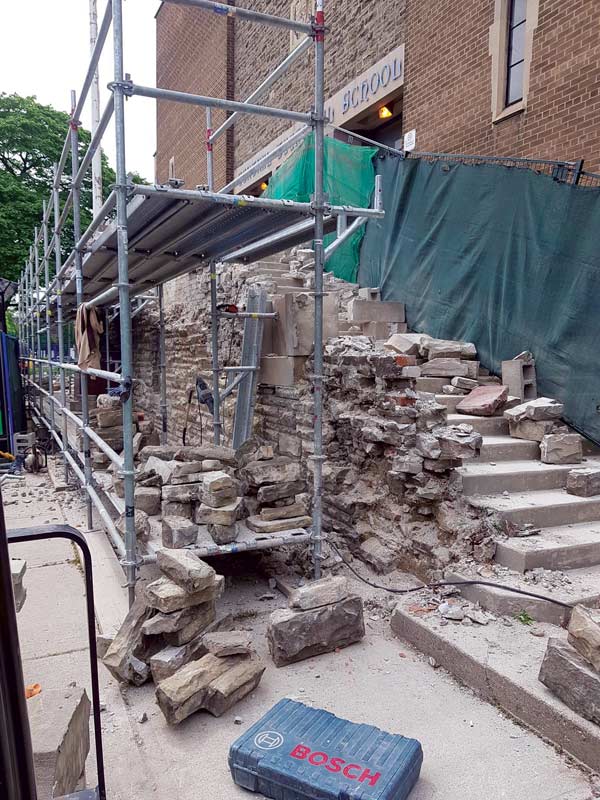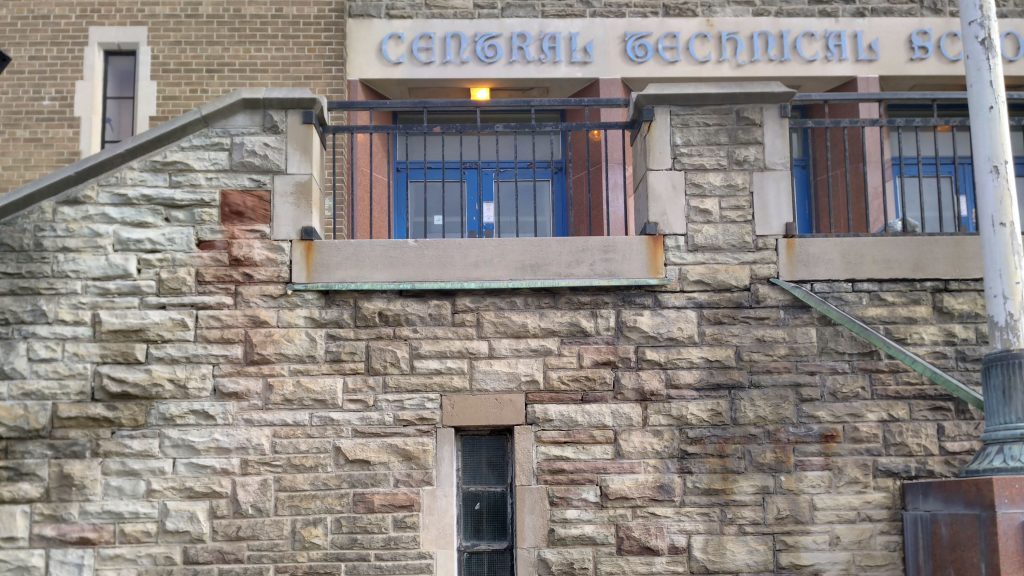The contract covering a historical stone restoration project undertaken by BRC Restoration specified the use of some specialized equipment. Imported from the UK, the DOFF Integra System uses superheated water to clean stone of paint, algae, moss…and graffiti. It’ll coming in handy to remove more than 65 years of signatures, drawings and messages left by students on the exterior stone stairs of one of the main buildings at Toronto’s Central Technical School.
Central Tech has earned an important place in Toronto construction history as a high school built in 1915 for the purpose of educating and training students for a growing economy that demanded more skilled tradespeople. The property has been designated under the Ontario Heritage Act, not only for the Collegiate Gothic styling of its main building but for its 1951 addition, the Art Centre where the stone stairway is located.
BRC Restoration is undertaking the work on the south stone stairway as masonry sub-contractor to general contractor Greco Construction, on behalf of its client the Toronto District School Board. The masonry contract covers repairs and reconstruction of two stairways and the replacement of associated railings leading up to a raised concrete slab at the entrance door.
It will appear exactly as it did when built,
— Arran Brannigan
BRC Restoration
“For a stairway to survive for 70 years in a high traffic area that experiences high exposure to the weather, it hasn’t done so badly,” says Arran Brannigan, president of BRC. “But at this point the whole structure is tipping out and shifting away from the school wall. Mortar joints are failing, there’s stone displacement and some stones are showing structural cracks due to shifting.”
Masons are tagging and cataloguing all of the stones to make sure they can be returned to their original location. Each of 1,000 stones have received their own ID number, were placed on pallets and shrink wrapped at an onsite compound.
The dimensional stone used for stringers is Indiana limestone, with replacement stone shipped from the U.S. The facing of the structure is primarily sandstone with samplings of limestone, both supplied by Owen Sound Ledgerock.

“The Ledgerock stoneworks is still in business,” says Brannigan. “We’re receiving sandstone which is sourced from what we suspect is the same quarry. When we receive a shipment, our masons cut and dress the rock to size.”
The larger chunks of Indiana limestone are being shipped to Old World Stone in Burlington, where they’re carved to spec and delivered to the worksite.
The original construction of the stairway is solid masonry throughout the entire structure. But typical of construction at the time, the core of the stairway is masonry infill.
“Using masonry rubble infill wasn’t uncommon at the time, but it wasn’t an ideal construction method,” says Brannigan. “If everything had been bonded and tied across the wythes with solid units, they might have gotten another 70 years out of it. We’ll be replacing the interior of the structure with a cast-in-place concrete back-up wall with reinforcement. From a heritage perspective it will appear exactly as it did when built, but it will out-perform the original.”
As the structure takes shape, metal hook dowels will be drilled and epoxied to further tie the new construction into the existing building.
Work on the project began in late June, as the school year ended. Three to four workers will remain onsite until the project is finished, with the original schedule set for the end of summer.
Once all stones are reinstalled, BRC will use the DOFF cleaner to non-destructively remove the graffiti from the stonework.
“You can tell the age of the graffiti by the wording the students used,” says Brannigan. “But it’s all treated equally. Every last word will be gone when we hand over the project.”











Recent Comments
comments for this post are closed